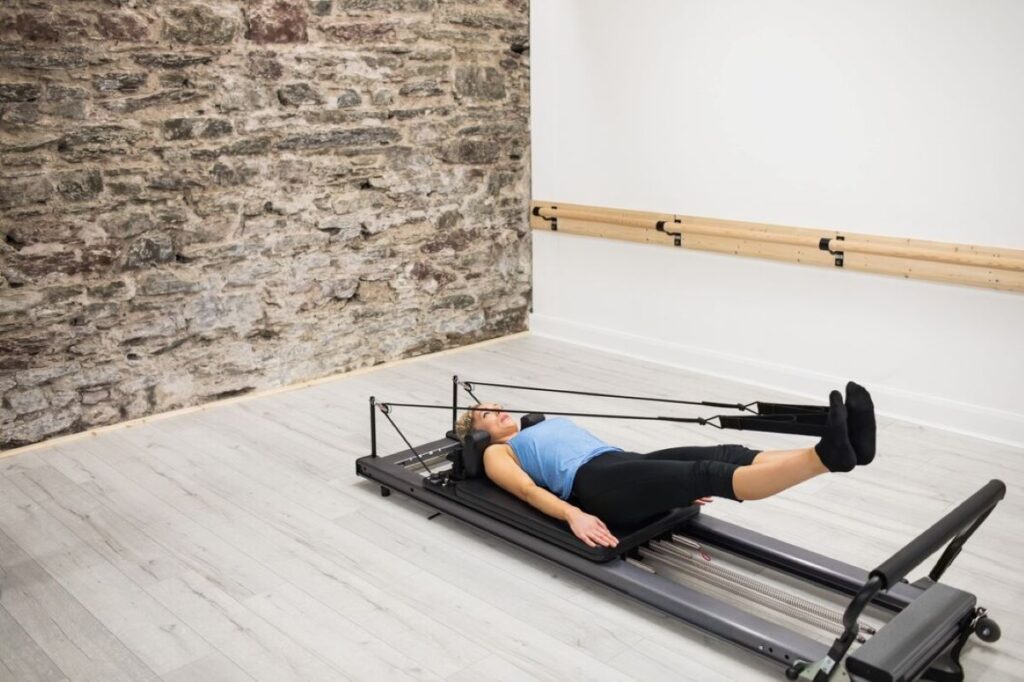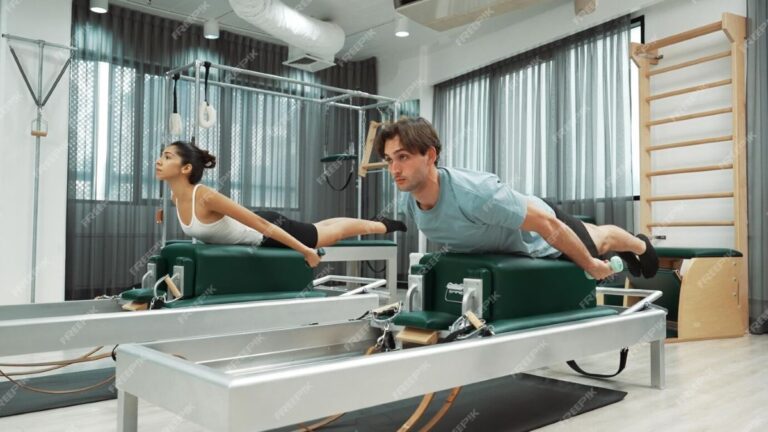Understanding Your Pilates Reformer Machine
When it comes to Pilates, a reformer machine offers an incredible range of exercises that can enhance your workout experience. Before you dive into your sessions, it’s crucial to understand the components and features of the machine you have at home. This knowledge will not only help you set it up correctly but will also allow you to maximize its potential for your fitness goals.
Key Components of a Pilates Reformer
Your home Pilates reformer machine consists of several key components, each playing a vital role in your exercise routine. The main parts include the frame, carriage, springs, footbar, shoulder rests, and straps. The frame provides stability and the structure needed for exercises, while the carriage glides back and forth, allowing you to perform various movements.
The springs are where the magic happens; they provide resistance and support, adjusting the intensity of your workout. The footbar and shoulder rests help you to stabilize your position as you perform exercises. Straps attached to the carriage allow for additional flexibility and extension during workouts. Understanding how to adjust the springs and position your body correctly can lead to more effective workouts and better results.
Safety Features to Keep in Mind
Safety is paramount when setting up and using your Pilates reformer. Look for features like non-slip surfaces, padded components, and locking systems on the springs. It’s also essential to ensure that the machine is assembled correctly and all parts are secure before each workout.
Regularly inspecting your reformer for wear and tear, especially the springs, is equally important. This ensures that you maintain a safe workout environment, free of any potential hazards. Additionally, consider using a mat or padding underneath your reformer to protect your flooring and provide extra stability. Familiarizing yourself with the safety features of your machine will not only enhance your confidence while exercising but also encourage you to explore more advanced movements as you progress in your Pilates journey.
Moreover, understanding the importance of proper alignment and body mechanics while using the reformer can significantly reduce the risk of injury. Engaging your core, maintaining a neutral spine, and being mindful of your movements will help you get the most out of each session. If you’re new to Pilates or the reformer, it might be beneficial to take a few classes with a certified instructor who can guide you through the nuances of the machine and ensure you are using it safely and effectively.
Preparing Your Space for the Pilates Reformer
While understanding the reformer itself is crucial, preparing your workout space can greatly enhance your Pilates experience at home. The area should be conducive to movement and should inspire you to work out regularly. Here’s how to set up a space that’s perfect for Pilates.
Choosing the Right Location
The location of your reformer can significantly affect your workout. Ideally, you want to aim for a space with ample natural light, which can uplift your mood and motivation. A living room or a spare room can work well. Just ensure there’s enough room to move freely around the machine.
Take into account the noise level in your chosen area, as a quiet space can foster concentration. If you live with others, let them know your workout schedule to minimize disturbances. Additionally, consider the temperature of the room; a comfortable climate can help you focus on your movements without distraction. If possible, keep a fan or heater nearby to adjust the temperature as needed, ensuring you can maintain your optimal performance during each session.
Ensuring Adequate Space
Once you’ve chosen your location, it’s critical to assess the space around your reformer. A good rule of thumb is to allow at least two to three feet on each side of the machine. This provides ample space for exercises and ensures you don’t accidentally bump into anything, which could lead to injury.
Keep the area organized and clutter-free. Store any accessories like mats, weights, or bands in a nearby shelf or basket, so you can access them easily but they don’t get in the way of your exercises. Consider incorporating a mirror into your setup; this can help you monitor your form and alignment during workouts. Mirrors not only allow for self-correction but also create a sense of space, making your workout area feel larger and more open. Furthermore, personalizing your space with motivational quotes or images can enhance your enthusiasm and commitment to your Pilates practice.
Step-by-Step Guide to Setting Up Your Pilates Reformer
Now that your space is ready, let’s dive into the steps to set up your Pilates reformer. Whether you’re new to Pilates or have experience, following this guide will help you ensure everything is in place for a productive workout.
Unpacking and Assembling the Machine
First things first, take a moment to unpack your reformer carefully. Lay out all the parts to familiarize yourself with them. Refer to the manufacturer’s assembly instructions for guidance. Usually, it involves attaching the footbar and shoulder rests as well as the straps.
Once assembled, give everything a quick inspection to make sure it’s sturdy and all components are secure. If you have a wooden reformer, check that there are no splinters or loose joints that could affect safety during your workouts. Additionally, ensure that the wheels are functioning smoothly, as this will enhance your experience by allowing for easy transitions between exercises. A well-maintained reformer not only boosts your confidence but also helps prevent injuries, making your sessions more enjoyable.
Adjusting the Settings for Your Needs
Every body is different, and so are our fitness levels. Take the time to adjust the settings on your reformer to meet your individual needs. Start by customizing the spring levels according to the exercises you plan to do. For beginners, lighter springs may be more manageable, while experienced users can opt for more resistance.
Also consider modifying the height of the footbar or the position of the straps to accommodate your body size and enhance comfort. Small adjustments can make a significant impact on your form and effort during workouts. Pay attention to the alignment of your body during exercises; improper settings can lead to strain or discomfort. It’s beneficial to keep a journal of your adjustments and how they affect your performance, allowing you to track your progress and make informed changes over time. This personalized approach not only fosters a deeper connection with your practice but also encourages continuous improvement and motivation on your Pilates journey. You may like to get a guideline about exercises and physical activity visit https://www.health.gov.au/topics/physical-activity-and-exercise/physical-activity-and-exercise-guidelines-for-all-australians.

Maintaining Your Pilates Reformer for Longevity
Now that you have your reformer set up, maintaining it is key to ensuring its longevity and performance. Regular care and checks will keep it operating smoothly, so you can focus on your workouts without any interruptions.
Regular Cleaning and Care
After each use, take a moment to wipe down the reformer with a gentle cleaner to remove sweat and dust. It helps maintain its appearance and function. Pay special attention to the straps and springs, as they can accumulate grime over time.
For wooden reformers, using a wood polish occasionally will keep the surface looking polished. Always check the manufacturer’s guidelines for recommended cleaning products to ensure you’re not damaging the machine.
Periodic Checks and Adjustments
Every few months, conduct a full check of the components — springs, straps, and frame. Look for signs of wear, and replace any parts as necessary. This regular upkeep will prevent any issues during your sessions and provide a safe workout environment.
Don’t hesitate to reach out to the manufacturer if you have any questions about replacements or repairs. Keeping your reformer in top shape enhances your experience and workouts!
Maximizing Your Workout with Proper Machine Setup
With your Pilates reformer set up, you’ll want to maximize your workouts to see optimal results. The way you align and adjust your machine can greatly impact your posture and overall effectiveness of each session.
Aligning the Machine for Optimal Posture
To get the most out of your Pilates routine, it’s essential to ensure your reformer is aligned correctly. Adjust the footbar and straps to your preferred height. Proper alignment allows you to maintain a correct posture, which is crucial for both effectiveness and safety during your workouts.
Before starting, take a moment to check your alignment with a mirror if possible. This visual feedback can guide you to correct your form, ensuring you’re activating the right muscles during each exercise.
Adjusting Resistance for Varied Workouts
One of the great advantages of a Pilates reformer is its adjustable resistance capabilities. Play around with different levels of spring resistance to tailor your workout intensity based on your day-to-day energy levels or fitness goals.
For varied workouts, focus on mixing up exercises and resistance levels. Combining lighter resistance with high-repetition moves can aid in endurance, while heavier resistance with fewer reps can help build strength. This variety keeps your workouts interesting and prevents fitness plateaus.
By following this guide on setting up your home Pilates reformer, you’re on your way to enjoying more effective and fulfilling workouts. Embrace your fitness journey and remember that consistency and proper setup are key to reaping the benefits of Pilates!
More to Read : Compact Pilates Reformer: Perfect for Small Spaces and Home Workouts


